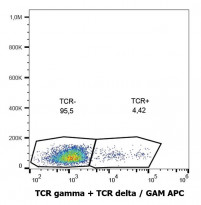ARG42289
anti-TCR gamma + TCR delta antibody [B1]
anti-TCR gamma + TCR delta antibody [B1] for Flow cytometry,IHC-Frozen sections,IHC-Formalin-fixed paraffin-embedded sections and Human,Primates
Overview
| Product Description | Mouse Monoclonal antibody [B1] recognizes TCR gamma + TCR delta |
|---|---|
| Tested Reactivity | Hu, NHuPrm |
| Tested Application | FACS, IHC-Fr, IHC-P |
| Specificity | The mouse monoclonal antibody B1 (also known as B1.1) recognizes an extracellular epitope of TCR gamma/delta, the subtype of T cell receptor expressed mainly in epithelial tissues and at the sites of infection. |
| Host | Mouse |
| Clonality | Monoclonal |
| Clone | B1 |
| Isotype | IgG1, kappa |
| Target Name | TCR gamma + TCR delta |
| Antigen Species | Human |
| Conjugation | Un-conjugated |
| Alternate Names | TCR gamma: TCRG TCR delta: TCRD; TCRDV1 |
Application Instructions
| Application Suggestion |
|
||||||||
|---|---|---|---|---|---|---|---|---|---|
| Application Note | * The dilutions indicate recommended starting dilutions and the optimal dilutions or concentrations should be determined by the scientist. |
Properties
| Form | Liquid |
|---|---|
| Purification | Purification with Protein A. |
| Buffer | PBS and 15 mM Sodium azide. |
| Preservative | 15 mM Sodium azide |
| Concentration | 1 mg/ml |
| Storage Instruction | For continuous use, store undiluted antibody at 2-8°C for up to a week. For long-term storage, aliquot and store at -20°C or below. Storage in frost free freezers is not recommended. Avoid repeated freeze/thaw cycles. Suggest spin the vial prior to opening. The antibody solution should be gently mixed before use. |
| Note | For laboratory research only, not for drug, diagnostic or other use. |
Bioinformation
| Gene Symbol | TRG; TRD |
|---|---|
| Gene Full Name | T cell receptor gamma locus; T cell receptor delta locus |
| Background | TCR gamma: T cell receptors recognize foreign antigens which have been processed as small peptides and bound to major histocompatibility complex (MHC) molecules at the surface of antigen presenting cells (APC). Each T cell receptor is a dimer consisting of one alpha and one beta chain or one delta and one gamma chain. In a single cell, the T cell receptor loci are rearranged and expressed in the order delta, gamma, beta, and alpha. If both delta and gamma rearrangements produce functional chains, the cell expresses delta and gamma. If not, the cell proceeds to rearrange the beta and alpha loci. This region represents the germline organization of the T cell receptor gamma locus. The gamma locus includes V (variable), J (joining), and C (constant) segments. During T cell development, the gamma chain is synthesized by a recombination event at the DNA level joining a V segment with a J segment; the C segment is later joined by splicing at the RNA level. Recombination of many different V segments with several J segments provides a wide range of antigen recognition. Additional diversity is attained by junctional diversity, resulting from the random addition of nucleotides by terminal deoxynucleotidyltransferase. Several V segments of the gamma locus are known to be incapable of encoding a protein and are considered pseudogenes. Somatic rearrangement of the gamma locus has been observed in T cells derived from patients with T cell leukemia and ataxia telangiectasia. [provided by RefSeq, Jul 2008] |
| Calculated MW | 19 kDa |
Images (1) Click the Picture to Zoom In






